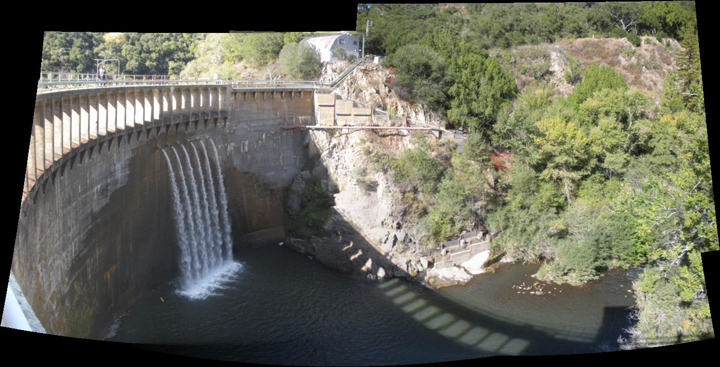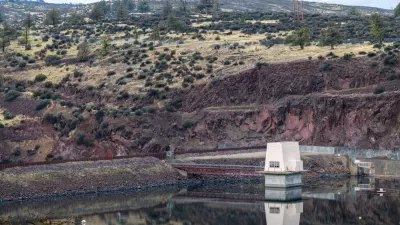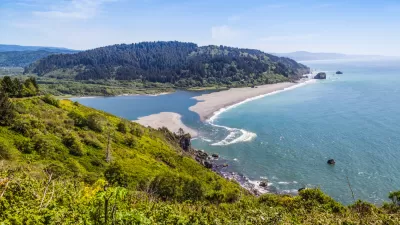Even in an epic drought, the long-awaited commencement of the $83 million San Clemente Dam removal project is welcomed as the obsolete dam posed a safety threat to downstream communities and provided very little water due to tremendous silt build-up.
San Clemente Dam, built in 1921 to provide water from the Carmel River for the Monterey Peninsula, is coming down, literally, "using a hoe ram, a kind of giant jackhammer chipping away at the concrete and reinforced steel structure," writes Jim Johnson for the Monterey Herald. At the same time, construction has begun on the new Carmel River channel with step pools to improve fish habitat [see photo 3 in photo gallery].

San Clemente Dam pre-destruction. Credit: San Clemente Dam Removal & Carmel River Reroute Project
After the dam flunked a seismic safety inspection in 1992, the owner, California American Water Company (Cal Am), with the encouragement of local, state, and federal legislators, settled on the "San Clemente Dam Removal & Carmel River Reroute Project." The removal of the 106-foot-high dam is the largest such project in the state's history and "could be a model for state water policy," writes Steve Rubenstein for the San Francisco Chronicle.
“Retrofitting it would have been like putting new tires on a car with a blown engine,” Monterey County Supervisor Dave Potter, in whose district the dam lies, said. “Dams are an antiquated technology. They were invented before Christ was born. They’re not good for the watershed, for the fish or for flood prevention.”
The "Background & History" section on the project website provides this explanation:
Strengthening the dam would resolve the public safety issues, but would not address other issues related to the dam such as impaired access for steelhead to 25 miles of upstream spawning and rearing habitat, disruption of sediment transport to the lower river and Carmel River beach, and ecological discontinuity of aquatic and riparian habitats.
"Cal Am project executive Rich Svindland called the beginning of demolition 'a huge milestone, there’s no question about that',” adds Johnson.
“We’ve reached the point of no return,” Svindland said. “I commend my fellow partners, the Coastal Conservancy and National Marine Fisheries, for getting to this point. We’re on the forefront of what will need to happen across the country, and we’ve proved it can be done.”
"Water for the county will come instead from existing underground wells," writes Rubenstein. "The huge pile of sediment — 2.5 million cubic yards of muck — will be allowed to remain in place." Water will continue to be supplied from the upstream Los Padres dam as well, though its future appears questionable.
The dam is expected to be removed entirely by the third week of August.
FULL STORY: San Clemente Dam teardown work begins; completion expected by end of month

Montreal Mall to Become 6,000 Housing Units
Place Versailles will be transformed into a mixed-use complex over the next 25 years.

Planetizen Federal Action Tracker
A weekly monitor of how Trump’s orders and actions are impacting planners and planning in America.

DARTSpace Platform Streamlines Dallas TOD Application Process
The Dallas transit agency hopes a shorter permitting timeline will boost transit-oriented development around rail stations.

Bend, Deschutes County Move to Restrict Major Homeless Encampment
City and county officials are closing off portions of an area known as Juniper Ridge where many unhoused residents find shelter, hoping to direct people to housing and supportive services.

High Housing Costs Driving Down Transit Ridership in LA
When neighborhoods gentrify and displace lower-income residents, transit ridership suffers, new research shows.

Iowa Legalizes Accessory Dwelling Units
A new law will allow property owners to build ADUs on single-family lots starting on July 1.
Urban Design for Planners 1: Software Tools
This six-course series explores essential urban design concepts using open source software and equips planners with the tools they need to participate fully in the urban design process.
Planning for Universal Design
Learn the tools for implementing Universal Design in planning regulations.
City of Mt Shasta
City of Camden Redevelopment Agency
City of Astoria
Transportation Research & Education Center (TREC) at Portland State University
City of Camden Redevelopment Agency
Municipality of Princeton (NJ)
Regional Transportation Commission of Southern Nevada





























